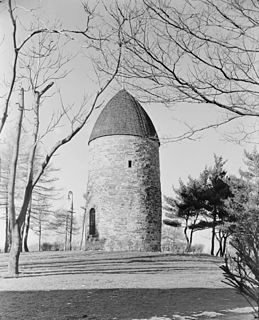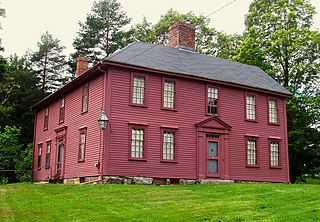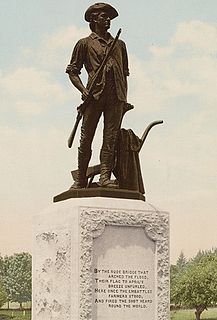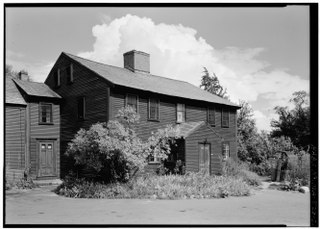Related Research Articles

Lexington is a suburban town in Middlesex County, Massachusetts, United States. It is 10 miles from Downtown Boston. The population was 31,394 at the 2010 census, which was estimated at 33,727 in 2018. Settled in 1641 as a farming community, it is well known as the site of the first shots of the American Revolutionary War, in the Battle of Lexington on April 19, 1775. It is home to Minute Man National Historical Park.

Patriots' Day is an annual event, formalized as several state holidays, commemorating the battles of Lexington, Concord, and Menotomy, some of the first battles of the American Revolutionary War. The holiday occurs on the third Monday of April each year, with celebrations including battle reenactments and the Boston Marathon.

Samuel Prescott was an American physician and a Massachusetts Patriot during the American Revolutionary War. He is best known for his role in Paul Revere's "midnight ride" to warn the townspeople of Concord, Massachusetts of the impending British army move to capture guns and gunpowder kept there at the beginning of the American Revolution. He was the only participant in the ride to reach Concord.

The Powder Alarm was a major popular reaction to the removal of gunpowder from a magazine by British soldiers under orders from General Thomas Gage, royal governor of the Province of Massachusetts Bay, on September 1, 1774. In response to this action, amid rumors that blood had been shed, alarm spread through the countryside to Connecticut and beyond, and American Patriots sprang into action, fearing that war was at hand. Thousands of militiamen began streaming toward Boston and Cambridge, and mob action forced Loyalists and some government officials to flee to the protection of the British Army.

The North Bridge, often colloquially called the Old North Bridge, is a historic site in Concord, Massachusetts spanning the Concord River. On April 19, 1775, the first day of the American Revolutionary War, provincial minutemen and militia companies numbering approximately 400 engaged roughly 90 British Army troops at this location. The battle was the first instance in which American forces advanced in formation on the British regulars, inflicted casualties, and routed their opponents. It was a pivotal moment in the Battles of Lexington and Concord and in American history. The significance of the historic events at the North Bridge inspired Ralph Waldo Emerson to refer to the moment as the "shot heard round the world."

Minute Man National Historical Park commemorates the opening battle in the American Revolutionary War. It also includes the Wayside, home in turn to three noted American authors. The National Historical Park is under the jurisdiction of the National Park Service and protects 970 acres (392.5 ha) in and around the Massachusetts towns of Lexington, Lincoln, and Concord.

Munroe Tavern, located at 1332 Massachusetts Avenue, Lexington, Massachusetts, is an American Revolutionary War site that played a prominent role in the Battle of Lexington and Concord. It is now preserved and operated as a museum by the Lexington Historical Society, with exhibits highlighting the role and perspective of the British soldiers during the outbreak of the war. The house is open for guided tours on weekends starting in April and daily from Memorial Day weekend until the end of October.

Buckman Tavern is a historic American Revolutionary War site associated with the revolution's very first battle, the 1775 Battle of Lexington and Concord. It is located on the Battle Green in Lexington, Massachusetts and operated as a museum by the Lexington Historical Society.

The battles of Lexington and Concord were the first military engagements of the American Revolutionary War. The battles were fought on April 19, 1775 in Middlesex County, Province of Massachusetts Bay, within the towns of Lexington, Concord, Lincoln, Menotomy, and Cambridge. They marked the outbreak of armed conflict between the Kingdom of Great Britain and its thirteen colonies in America.

Isaac Davis was a gunsmith and a militia officer who commanded a company of Minutemen from Acton, Massachusetts, during the first battle of the American Revolutionary War. In the months leading up to the Revolution, Davis set unusually high standards for his company in terms of equipment, training, and preparedness. His company was selected to lead the advance on the British Regulars during the Battle of Concord because his men were entirely outfitted with bayonets. During the American advance on the British at the Old North Bridge, Davis was among the first killed and was the first American officer to die in the Revolution.
William Sutherland was a British officer during the American Revolution.

The Reuben Brown House is a colonial style house located in Concord, Massachusetts.

Colonel William Munroe was a soldier in the American Revolutionary War. He was the orderly sergeant of the Lexington militia at the Battle of Lexington and Concord and as a lieutenant at the Battle of Saratoga. He was also a militia colonel and a prominent man politically in the town of Lexington.

Minutemen were civilian colonists who independently formed militia companies self-trained in weaponry, tactics, and military strategies, comprising the American colonial partisan militia during the American Revolutionary War. They were known for being ready at a minute's notice, hence the name. Minutemen provided a highly mobile, rapidly deployed force that enabled the colonies to respond immediately to war threats.
Thaddeus Bowman was the last scout sent out by Capt. John Parker at Lexington, Massachusetts, but the only one to find the approaching British troops and get back to warn the militia on the first day of the American Revolution.

Hartwell Tavern is a historic American Revolutionary War site associated with the revolution's first battle, the 1775 battles of Lexington and Concord. It is located on North County Road, just off Battle Road in Lincoln, Massachusetts, and operated as a historic house museum by the National Park Service as part of the Minute Man National Historical Park. Built in 1733, in what was then Concord, it is staffed from Memorial Day (May) weekend to October by park rangers dressed in colonial attire who offer programs daily.

The Minute Man is an 1874 sculpture by Daniel Chester French located in Minute Man National Historical Park in Concord, Massachusetts. It was created between 1871 and 1874 after extensive research, and originally intended to be made of stone. The medium was switched to bronze and it was cast from ten Civil War-era cannons appropriated by Congress.

The Samuel Hartwell House is a historic American Revolutionary War site associated with the revolution's first battle, the 1775 battles of Lexington and Concord. Built around 1694, in what was then Concord, it was located on North County Road, just off Battle Road in today's Lincoln, Massachusetts, and about 700 feet east of Hartwell Tavern, which Hartwell built for his son, Ephraim, and his newlywed wife, Elizabeth, in 1733. The site is part of today's Minute Man National Historic Park.

The Captain William Smith House is a historic American Revolutionary War site in Lincoln, Massachusetts, United States. Part of today's Minute Man National Historic Park, it is associated with the revolution's first battle, the 1775 battles of Lexington and Concord. Believed to have been built in 1692, in what was then Concord, it is believed to be the oldest house in Lincoln.
The Job Brooks House is a historic American Revolutionary War site in Lincoln, Massachusetts, United States. It is part of today's Minute Man National Historic Park.
References
- ↑ "Minute Man National Historical Park". National Park Services. Retrieved 12 March 2015.
- ↑ Simone, Alina (21 April 2014). "Henry Liu is a musket-carrying member of the Lexington Minute Men. He's also Chinese American". Public Radio International. Retrieved 13 February 2015.
- ↑ "Reenactment Information". Boston Central. Retrieved 12 March 2015.
- ↑ "The Lexington Minutemen" . Retrieved 13 February 2015.
- ↑ "History of the American Contingent". The American Contingent of the Tenth Regiment of Foot. Archived from the original on 21 February 2015. Retrieved 13 February 2015.
- ↑ Tempera, Jacqueline. "Lexington police step up Patriots Day security". Boston Globe. Retrieved 13 March 2015.
- ↑ Miller, Joshua. "Battle of Lexington reenactment draws throngs". Boston Globe. Retrieved 13 March 2015.
- ↑ "Patriots Day". Lexington Historical Society. Retrieved 13 March 2015.
- ↑ "Historic Sites". Lexington Historical Society. Retrieved 13 March 2015.
- ↑ Parker, Brock. "History revisited Munroe Tavern offers British take on April 19, 1775". The Boston Globe. Retrieved 13 March 2015.